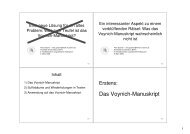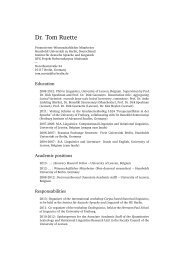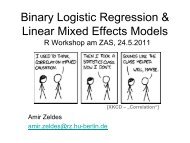Lexical variation in aggregate perspective
Lexical variation in aggregate perspective
Lexical variation in aggregate perspective
You also want an ePaper? Increase the reach of your titles
YUMPU automatically turns print PDFs into web optimized ePapers that Google loves.
<strong>Lexical</strong> <strong>variation</strong> <strong>in</strong> <strong>aggregate</strong> <strong>perspective</strong> 105<br />
With these three dimensions (country, register, topic) and two levels for each dimension<br />
8 comb<strong>in</strong>ations are possible. These comb<strong>in</strong>ations, e.g. Belgian quality newspapers<br />
on economy (abbreviated as qnp.be.e), will be represented by the subcorpora,<br />
for which we will calculate the pair wise distances. However, to <strong>in</strong>crease the number<br />
of data po<strong>in</strong>ts and <strong>in</strong> order to verify the <strong>in</strong>ternal consistency of the subcorpora, we divided<br />
every subcorpus <strong>in</strong>to two equally sized groups (abbreviated as e.g. qnp.be.e.0<br />
and qnp.be.e.1). In total then, we counted the frequencies of the l<strong>in</strong>guistic characteristics<br />
which we <strong>in</strong>troduce above, <strong>in</strong> 16 subcorpora. A snippet of this <strong>in</strong>put data is presented<br />
<strong>in</strong> the appendix to this paper.<br />
Given the omnipresent country dimension <strong>in</strong> the <strong>in</strong>put features, the primary <strong>variation</strong>al<br />
dimension that could be expected to be revealed among the subcorpora is the<br />
Belgian Dutch versus Netherlandic Dutch dimension. Or <strong>in</strong> terms that relate to the<br />
distance measurement method: <strong>in</strong> a pair-wise comparison of subcorpora with a national<br />
difference, the distance will be bigger than a comparison of two subcorpora<br />
with the same national affiliation. Because the typical Belgian Dutch words are sometimes<br />
restricted to a specific register, e.g. colloquialisms, a register dist<strong>in</strong>ction should<br />
emerge, as well. And as words and their conceptual categories are <strong>in</strong>evitably sensitive<br />
to topic, we would expect the difference between political and economical subcorpora<br />
to emerge, too. However, the register and topic dimension should be secondary to the<br />
country dimension.<br />
4.1 Results of the profile-based method<br />
We first look <strong>in</strong>to the results of the profile-based approach, <strong>in</strong>troduced above. To the<br />
selected Belgian Dutch items on the RBBN list, we added the knowledge which alternatives<br />
are conceptually equivalent General Dutch words. In other words, we <strong>in</strong>troduce<br />
conceptually controlled profile <strong>in</strong>formation to the distance metric. A profile thus consists<br />
of a Belgian Dutch word from the RBBN list, together with its general Dutch alternative.<br />
Remember that the underly<strong>in</strong>g distance metric is basically a City-Block distance<br />
measure (see Formula 4). Now, we zoom <strong>in</strong> on the two- and three-dimensional visualizations<br />
of all the pair wise profile-based distances between the subcorpora, made<br />
by means of non-metric two-way one-mode Multidimensional Scal<strong>in</strong>g (Cox and Cox<br />
2001), as can be seen <strong>in</strong> Figure 2. 5<br />
5 The coord<strong>in</strong>ates of a Multidimensional Scal<strong>in</strong>g solution can be scaled freely, as long as the same<br />
scal<strong>in</strong>g is applied to all dimensions. Therefore, we discarded a scale on the axes, as these numbers<br />
would not be <strong>in</strong>sightful. However, we made sure that the x and y (and z for three-dimensional solutions)<br />
axes are always equal, so that the distances between the subcorpora on the different dimensions<br />
can be <strong>in</strong>terpreted.






